Lecture 7: State Machines
Contributed by: Chis Moreton
Ported over and converted into an .md file
Week 07 - State Machines
This is a written version of Lecture #7.
It covers commit schemes and state machines.
This week we were using Plutus commit
530cc134364ae186f39fb2b54239fb7c5e2986e9
Introduction
In this lecture we will look at state machines. State machines can be very useful for writing shorter and more concise contracts, both on-chain and off-chain. There is higher level support for state machines in the Plutus libraries that builds on top of the lower level mechanisms we have seen so far.
As a running example, we are going to implement a little game, played between Alice and Bob. It\'s a bit like Rock, Paper, Scissors, but even simpler, because there are only two options.
Alice and Bob both have two options, they can either play 0 or 1.

If there were to play this game while being physically in the same room, they would make their moves at the same time. There would be one gesture for 0 and one gesture for 1, they would raise their hands simultaneously, and, depending on what they play, one of them wins.
If they both play the same number, Alice wins. If they play different numbers, Bob wins.
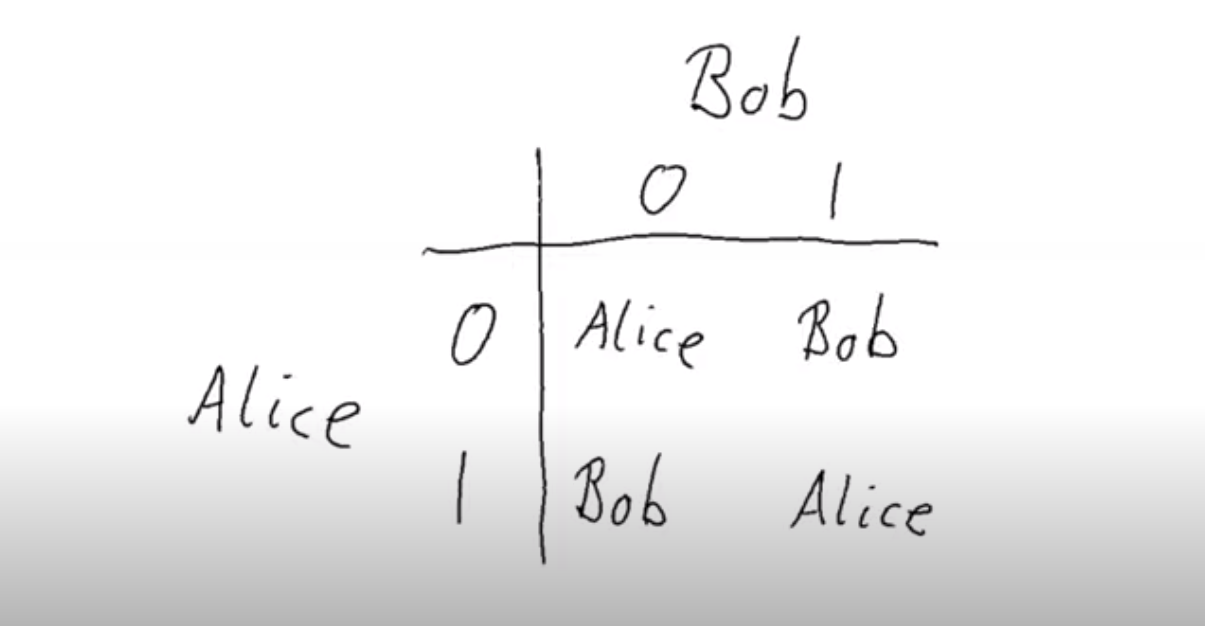
Now let\'s imagine that Alice and Bob can\'t meet in person but that they still want to play the game. So, they decide to play it via mail - email or snail mail, it doesn\'t matter. How would that work?
Alice could send her move to Bob.
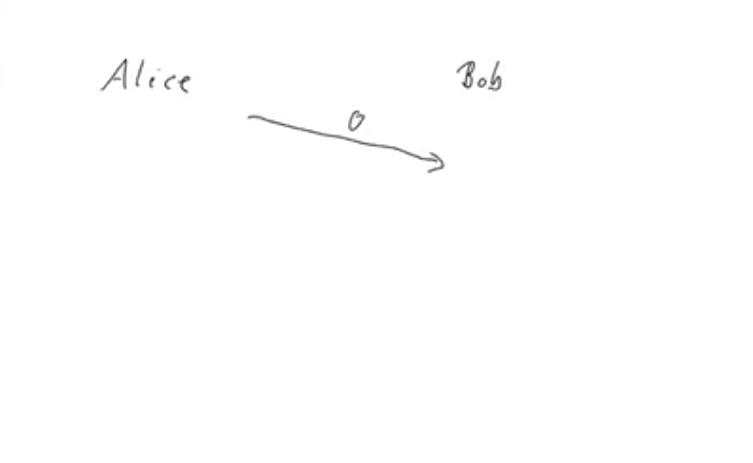
This, however, gives a very unfair advantage to Bob, because now he opens Alice\'s mail, see that she has played 0, and he can simply reply with 1, and he wins.
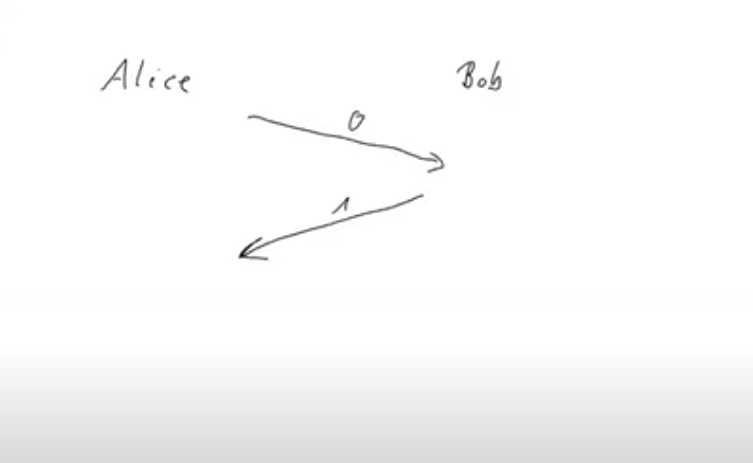
And, if Alice plays 1, Bob can simply respond with 1. So Bob always wins, at least if he is unfair.
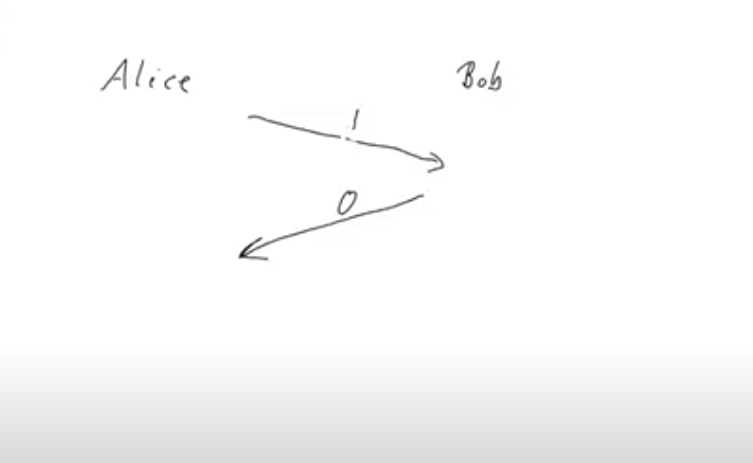
What can we do about that?
There\'s a very clever trick which is often used in cryptographic protocols, and that is commit schemes. The idea is that Alice doesn\'t reveal her choice to Bob, but she commits to it, so that she cannot later change her mind.
One way to make that work is using hash functions.
Hashes are all over the place in the blockchain world. We have seen that script addresses are just the hash of the Plutus code script, and we have seen lots of examples of public key hashes.
A hash function is a one-way function. Given a hash, tt is difficult, or impossible, to reconstruct the original byte string that was hashed.
So, one way we could try to make this work is that, instead of Alice sending her choice to Bob, she instead sends the hash of her choice.
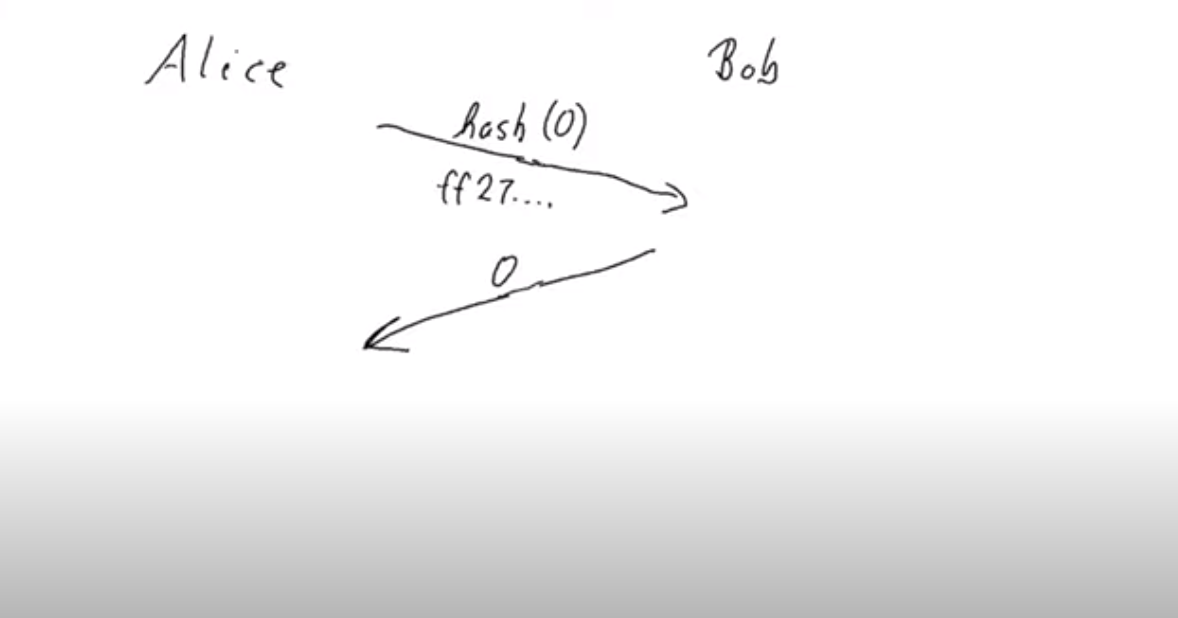
Bob then sees this cryptic byte string and he has no idea whether Alice picked 0 or 1.
Bob then replies with his move, picking, for example 0. There is no need for him to use a hash, he can just send his response in clear text.
Now, Alice would have won. But perhaps Bob doesn\'t believe her. So there is one additional step that Alice has to take.
Alice has to send her actual choice to Bob in clear text. Bob then has to check that the hash of her choice is indeed the same as the hash Alice sent earlier.
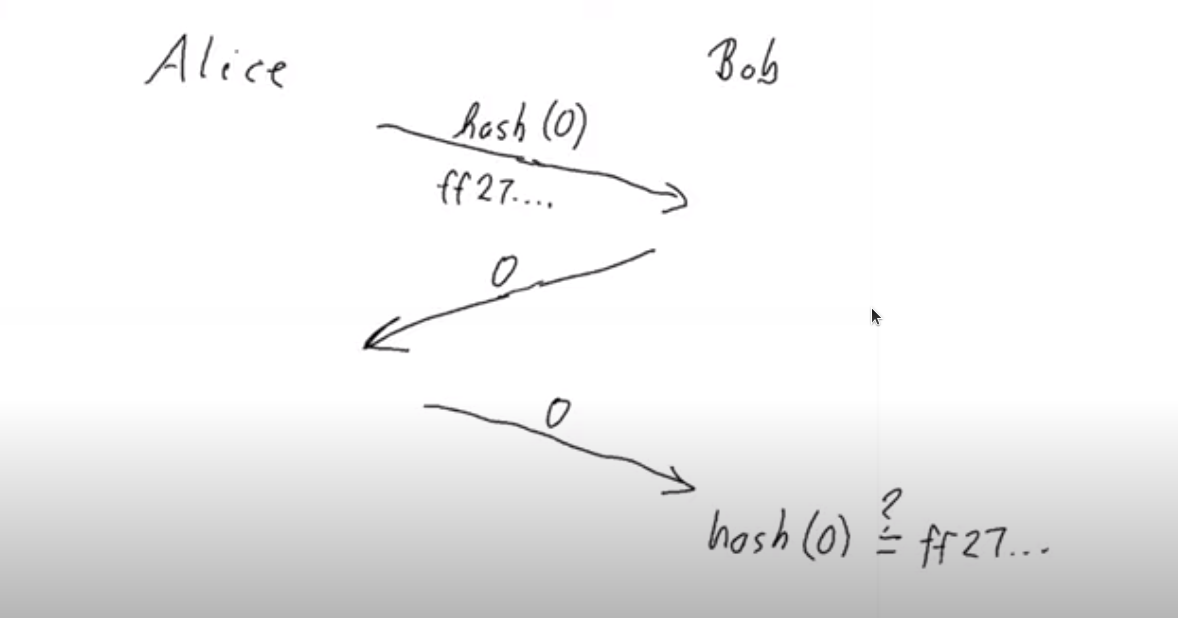
If it is, then he knows sees that Alice is not lying and that indeed he lost. If it does not match, then he knows that Alice is cheating and he would win.
This all sounds promising, but there is one big problem with it.
In this game there are only two choices, 0 and 1. Which means that there are only two possible hashes. They may look very cryptic to Bob the first time they play, but before long he will notice that he always sees one of only two possible hashes, and then he can know which choice Alice made.
This is almost as bad as if Alice had just sent her choice in clear text.
What we can do about this is that, instead of sending the hash of her choice, she instead first selects an arbitrary byte string and then hashes the concatenated of this byte string and her choice. The arbitrary byte string that Alice chooses is called a nonce - a number to be used just once.
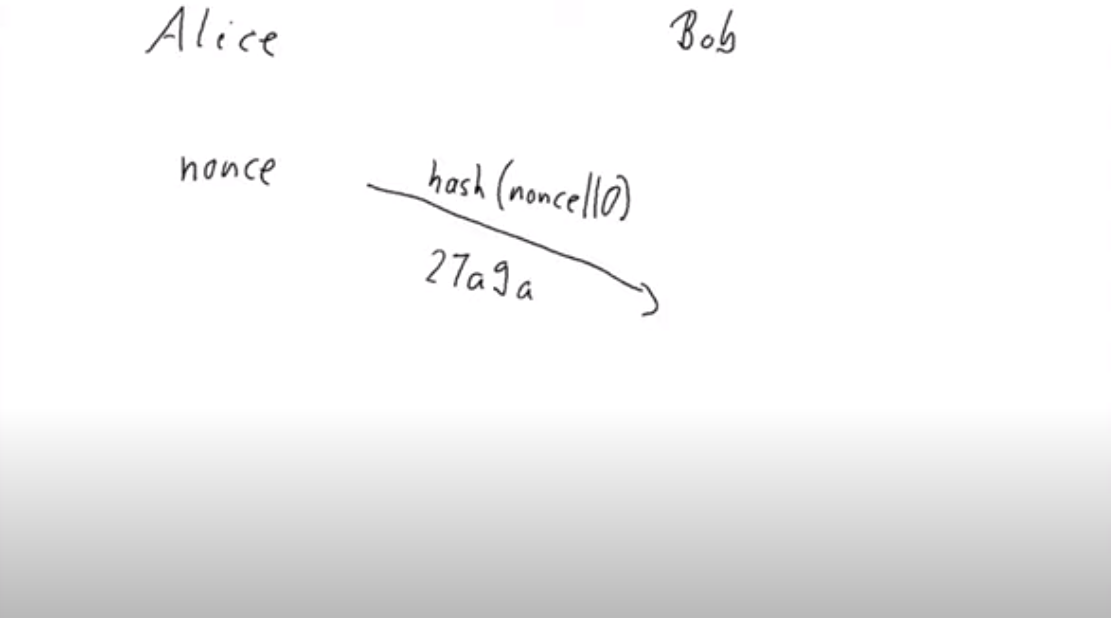
So now, it is not always the same byte string if she picks 0, provided she chooses some random, unpredictable nonce.
Now, Bob receives this and we proceed as before - Bob sends his choice, and then, in the third message Alice needs to send not only her original choice, but she also has to send the nonce as well.
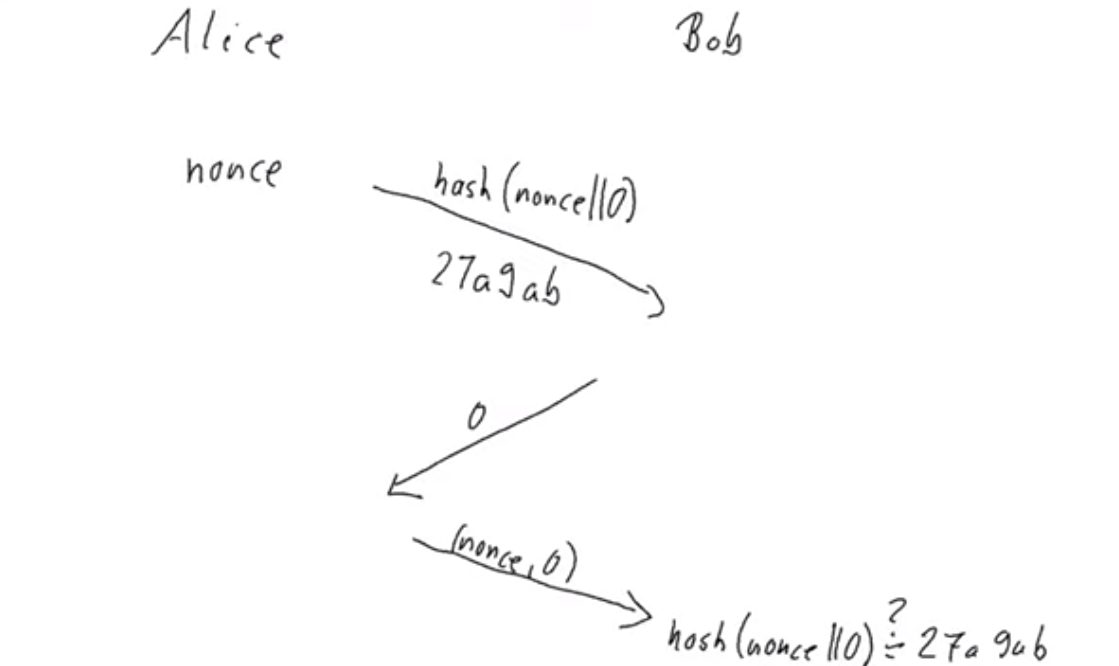
And then Bob checks that the hash of Alice\'s claimed nonce concatenated with her choice is indeed the hash that he originally received. If it is, he knows he lost, and if it is not, he knows that she tried to cheat him.
This works very nicely and this is what we will try to implement in Cardano. First we will do it using techniques we have already seen, and then we will see how, by using state machines, the code can be much clearer and much shorter.
Code Example 1
We can imagine that, at the start of the game, Alice and Bob have put down the same amount of money each and that the winner will take it all.
The game starts with Alice posting her hash, as described above. Bob, if he plays along, will post his own choice. At this point, we have Alice\'s hash and Bob\'s choice.
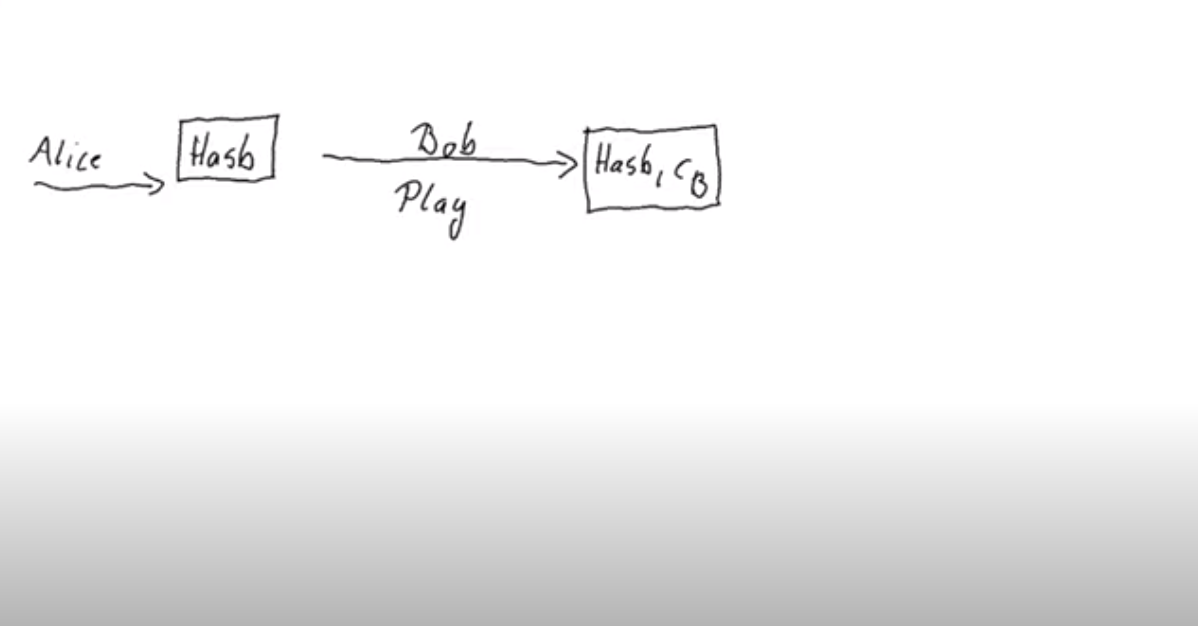
If, at this point, Alice realizes that she has won, based on Bob\'s choice, she can reveal her secret, the game ends, and she has won.
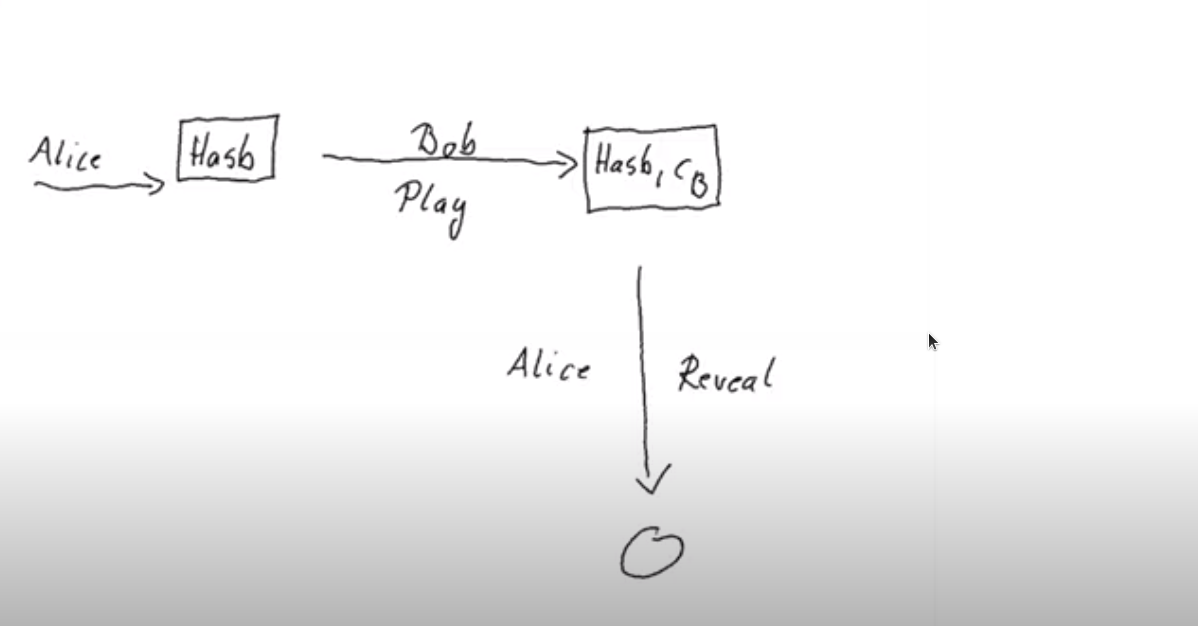
If, however, after Bob makes his move, Alice sees that she has lost, there is no need for her to do anything. After a certain deadline has been reached, if Alice has not responded, Bob will be able to claim the funds.
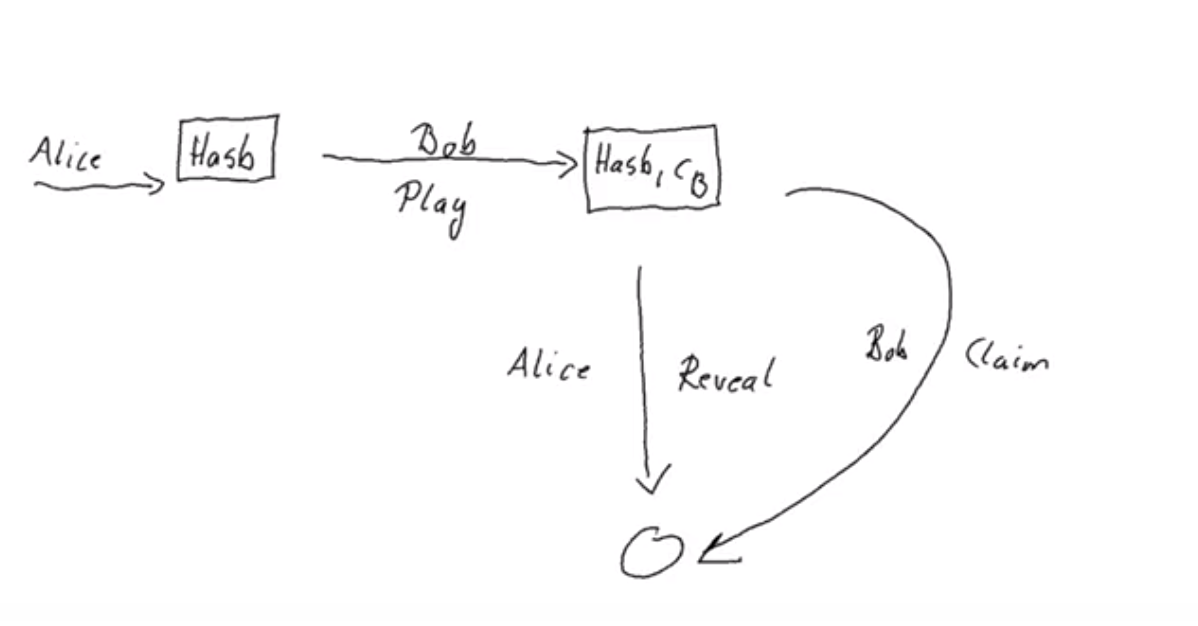
There is a another scenario. Perhaps, after Alice starts playing, Bob simply isn\'t interested. In this case, there must be a way for Alice to get her own money back.
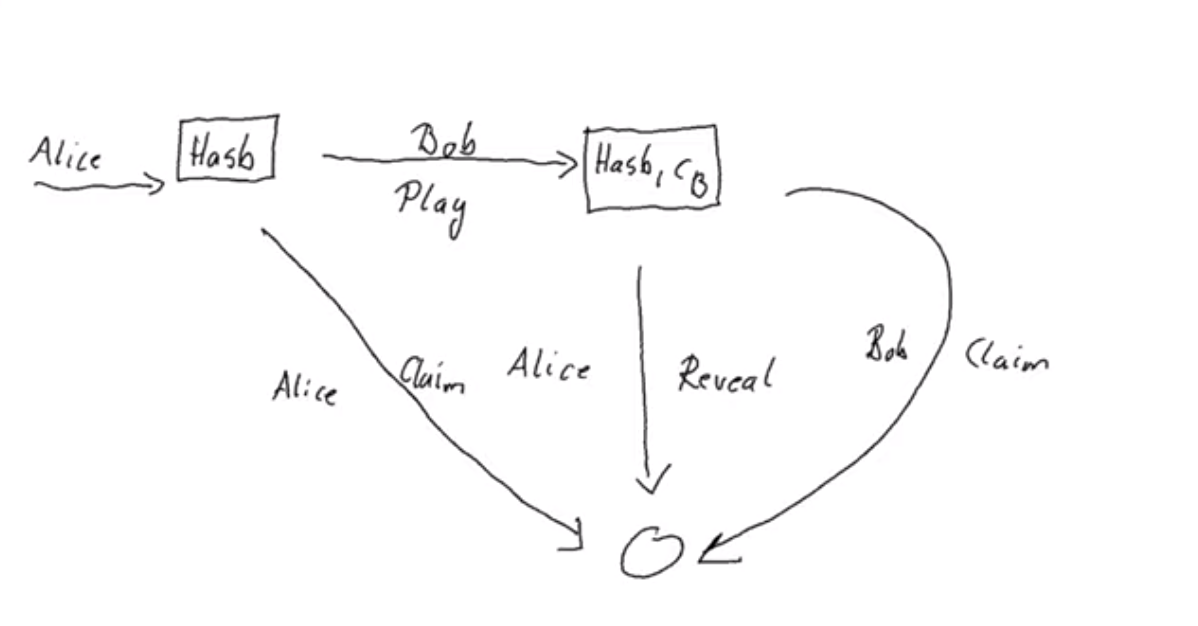
As mentioned, our first attempt at coding this in Plutus will be using the techniques we have learned in previous lectures.
The code we are working with is in the following module
We call the game EvenOdd due to the fact that if the sum of the numbers is even, then the first player wins, and if the sum is odd, the second player wins.
In our code we will call the players first and second rather than Alice and Bob.
On chain
We define a data type Game which will be used as a parameter for the contract.
data Game = Game
{ gFirst :: !PubKeyHash
, gSecond :: !PubKeyHash
, gStake :: !Integer
, gPlayDeadline :: !Slot
, gRevealDeadline :: !Slot
, gToken :: !AssetClass
} deriving (Show, Generic, FromJSON, ToJSON, Prelude.Eq, Prelude.Ord)
The players are identified by their public key hashes as gFirst and gSecond.
The number of lovelace to be used as stake in the game is represented by gStake - This stake must be provided by each player.
There are two deadlines. The gPlayDeadline is the slot by which the second player must make their move. In the case where the second player has made a move, the gRevealDeadline is the slot by which player 1 must claim victory by revealing his nonce.
Finally we have a token represented by gToken. This will be the same trick that we used for the oracle. It will be an arbitrary NFT, used to identify the right instance of the UTxO that we are using. The idea is to use the datum sitting at a UTxO in this contract\'s script address to keep track of where we are in the game.
Next, we define the two moves that the players can make.
data GameChoice = Zero | One
deriving (Show, Generic, FromJSON, ToJSON, ToSchema, Prelude.Eq, Prelude.Ord)
instance Eq GameChoice where
{-# INLINABLE (==) #-}
Zero == Zero = True
One == One = True
_ == _ = False
We need Plutus Eq for the instance, but it is not possible to declare that in the deriving clause, which is why the Eq in the deriving clause is qualified as being from the standard Haskell Prelude.
Note that we have used the INLINABLE pragma on the Eq instance for GameChoice. This is again to make it compatible with the Template Haskell we will need to use.
For state, we will use a type called GameDatum.
data GameDatum = GameDatum ByteString (Maybe GameChoice)
deriving Show
instance Eq GameDatum where
{-# INLINABLE (==) #-}
GameDatum bs mc == GameDatum bs' mc' = (bs == bs') && (mc == mc')
Here, the ByteString is the hash that the first player submits, and Maybe GameChoice is either Just the move of the second player, or Nothing, if they have not yet moved.
Now we come to the redeemer, and we will use a custom type for this as well.
Here Play is where the second player moves and, as an argument, it has a GameChoice. Reveal is for the case where the first player has won and must prove that by revealing their nonce, and the nonce is represented by the ByteString argument. We don\'t need to include the move for the Reveal, as they will only reveal if they have won, and we know what move makes them win.
ClaimFirst is when the first player claims back the stake in the even that the second player does not make a move by the play deadline. ClaimSecond is for the case when the first player does not reveal by the reveal deadline.
We then have our lovelaces helper function which we have used in other scripts, which gets the number of lovelaces held in a Value.
And we have a helper function gameDatum which behaves exactly the same way as the function oracleValue, which you can find in the notes from lecture 6.
gameDatum :: TxOut -> (DatumHash -> Maybe Datum) -> Maybe GameDatum
gameDatum o f = do
dh <- txOutDatum o
Datum d <- f dh
PlutusTx.fromData d
Now we come to the core business logic in the mkGameValidator function.
mkGameValidator :: Game -> ByteString -> ByteString -> GameDatum -> GameRedeemer -> ScriptContext -> Bool
mkGameValidator game bsZero' bsOne' dat red ctx =
...
The first argument is the Game parameter discussed above.
The second and the third arguments are somewhat of a nuisance. We just need them due to the fact that it is not possible to use string literals to get ByteStrings in Haskell that is compiled to Plutus core. And, we want string literals representing the 0 and 1 choices. So bsZero\' will hold \"0\" and beOne\' will hold \"1\". You will see how we pass these in as auxiliary arguments later.
Then we pass in the usual arguments for datum, redeemer and context.
Let\'s look at some helper functions first. There are three functions we have used before and discussed in lecture 6.
info :: TxInfo
info = scriptContextTxInfo ctx
ownInput :: TxOut
ownInput = case findOwnInput ctx of
Nothing -> traceError "game input missing"
Just i -> txInInfoResolved i
ownOutput :: TxOut
ownOutput = case getContinuingOutputs ctx of
[o] -> o
_ -> traceError "expected exactly one game output"
Note the ownInput should never fail as we are in the process of validating a UTxO.
The outputDatum helper makes use of the GameDatum type which we defined earlier. Given the case we have exactly one output (the return from ownOutput), it will give us the datum.
outputDatum :: GameDatum
outputDatum = case gameDatum ownOutput (`findDatum` info) of
Nothing -> traceError "game output datum not found"
Just d -> d
The checkNonce function is for the case where the first player as won and wants to prove it by revealing their nonce. The first argument is hash that was original sent, the second argument is the nonce that is being revealed.
For the GameChoice-typed parameter, we will be passing in the move made by player 2. This should be the same as the move made by player 1, and this is what this function will determine using the hash and the nonce.
In order to check the hash of the nonce concatenated with the GameChoice, we use a helper function to convert the GameChoice to a ByteString. Note that the use of the cFirst and cSecond in the checkNonce function could be swapped around, and the function would work just the same - the difference between the two is that one is a GameChoice and one is a ByteString.
checkNonce :: ByteString -> ByteString -> GameChoice -> Bool
checkNonce bs nonce cSecond = sha2_256 (nonce `concatenate` cFirst) == bs
where
cFirst :: ByteString
cFirst = case cSecond of
Zero -> bsZero'
One -> bsOne'
Finally, there is the question of what happens to the NFT once the game is over and there is no game address anymore. The way we have implemented it here, is that the NFT goes back to the first player. The first player needs it in the beginning to kick off the game and put the NFT into the correct UTxO, so it is reasonable to give it back the player 1 in the end.
To verify that this condition is met, we have created a helper function called nftToFirst.
nftToFirst :: Bool
nftToFirst = assetClassValueOf (valuePaidTo info $ gFirst game) (gToken game) == 1
Now that we have covered the helper functions, let\'s look at the conditions.
There is one condition that covers all the cases, and that is that the input we are validating must contain the NFT.
traceIfFalse "token missing from input" (assetClassValueOf (txOutValue ownInput) (gToken game) == 1) &&
After that, the rules depend on the situation.
The first situation is the one where the second player has not yet moved, and they are just now making their move.
(GameDatum bs Nothing, Play c) ->
traceIfFalse "not signed by second player" (txSignedBy info (gSecond game)) &&
traceIfFalse "first player's stake missing" (lovelaces (txOutValue ownInput) == gStake game) &&
traceIfFalse "second player's stake missing" (lovelaces (txOutValue ownOutput) == (2 * gStake game)) &&
traceIfFalse "wrong output datum" (outputDatum == GameDatum bs (Just c)) &&
traceIfFalse "missed deadline" (to (gPlayDeadline game) `contains` txInfoValidRange info) &&
traceIfFalse "token missing from output" (assetClassValueOf (txOutValue ownOutput) (gToken game) == 1)
Here, the first part is the GameDatum and it contains the first player\'s hash and a Nothing which shows that the second player has not yet moved. The second part is the GameRedeemer and has been determined to be of type Play GameChoice. We assign the GameChoice part to c using pattern matching.
We check that the second player has signed the transaction.
Then, we check that the first player\'s stake is present in the input.
The output should have the second player\'s stake added to the total stake.
traceIfFalse "second player's stake missing" (lovelaces (txOutValue ownOutput) == (2 * gStake game))
We now exactly what the datum of the output must be. It must be the same hash, plus the move made by the second player.
The, the move must happen before the play deadline.
And finally, the NFT must be passed on in the output UTxO.
traceIfFalse "token missing from output" (assetClassValueOf (txOutValue ownOutput) (gToken game) == 1)
The second situation is where both players have moved, and the second player discovers that they have won. In order to prove that and get the winnings, they have to reveal their nonce.
So, the transaction must be signed by the first player, the nonce must indeed agree with the hash submitted earlier, it must be done before the reveal deadline, the input must contain both players\' stakes and, finally, the NFT must go back to the first player.
(GameDatum bs (Just c), Reveal nonce) ->
traceIfFalse "not signed by first player" (txSignedBy info (gFirst game)) &&
traceIfFalse "commit mismatch" (checkNonce bs nonce c) &&
traceIfFalse "missed deadline" (to (gRevealDeadline game) `contains` txInfoValidRange info) &&
traceIfFalse "wrong stake" (lovelaces (txOutValue ownInput) == (2 * gStake game)) &&
traceIfFalse "NFT must go to first player" nftToFirst
Next we have the case where the second player doesn\'t move within the deadline, and the first player is reclaiming their stake. Here, the first player must have signed the transaction, the play deadline must have passed, their stake must be present, and the NFT must go back to the first player.
(GameDatum _ Nothing, ClaimFirst) ->
traceIfFalse "not signed by first player" (txSignedBy info (gFirst game)) &&
traceIfFalse "too early" (from (1 + gPlayDeadline game) `contains` txInfoValidRange info) &&
traceIfFalse "first player's stake missing" (lovelaces (txOutValue ownInput) == gStake game) &&
traceIfFalse "NFT must go to first player" nftToFirst
Finally, the case where both players have moved and the first player has either lost or not revealed in time, so the second player is claiming the winnings. This time, the transaction must be signed by the second player, the reveal deadline must have passed, both players\' stakes must be present, and the NFT must, as usual, go back to the first player.
(GameDatum _ (Just _), ClaimSecond) ->
traceIfFalse "not signed by second player" (txSignedBy info (gSecond game)) &&
traceIfFalse "too early" (from (1 + gRevealDeadline game) `contains` txInfoValidRange info) &&
traceIfFalse "wrong stake" (lovelaces (txOutValue ownInput) == (2 * gStake game)) &&
traceIfFalse "NFT must go to first player" nftToFirst
These four cases are all the legitimate cases that we can have, so in all other cases we fail validation.
So now let\'s look at the rest of the on-chain code.
As usual, we define a data type that holds the information about the types the datum and redeemer.
data Gaming
instance Scripts.ScriptType Gaming where
type instance DatumType Gaming = GameDatum
type instance RedeemerType Gaming = GameRedeemer
And we define the ByteStrings that will be used to represent the two choices. These values are completely arbitrary - they just can\'t be the same as each other.
Boilerplate to compile our parameterized mkGameValidator to Plutus code. We apply the three parameters, Game and the two ByteStringss. Remember that, we need to pass in these ByteString parameters because we can\'t refer to ByteStrings as string literals within Plutus.
gameInst :: Game -> Scripts.ScriptInstance Gaming
gameInst game = Scripts.validator @Gaming
($$(PlutusTx.compile [|| mkGameValidator ||])
`PlutusTx.applyCode` PlutusTx.liftCode game
`PlutusTx.applyCode` PlutusTx.liftCode bsZero
`PlutusTx.applyCode` PlutusTx.liftCode bsOne)
$$(PlutusTx.compile [|| wrap ||])
where
wrap = Scripts.wrapValidator @GameDatum @GameRedeemer
The usual boilerplate for validator and address.
gameValidator :: Game -> Validator
gameValidator = Scripts.validatorScript . gameInst
gameAddress :: Game -> Ledger.Address
gameAddress = scriptAddress . gameValidator
Now, as preparation for the off-chain code, we will need to be able to find the right UTxO - the one that carries the NFT. To do this we will write a helper function called findGameOutput.
findGameOutput :: HasBlockchainActions s => Game -> Contract w s Text (Maybe (TxOutRef, TxOutTx, GameDatum))
findGameOutput game = do
utxos <- utxoAt $ gameAddress game
return $ do
(oref, o) <- find f $ Map.toList utxos
dat <- gameDatum (txOutTxOut o) (`Map.lookup` txData (txOutTxTx o))
return (oref, o, dat)
where
f :: (TxOutRef, TxOutTx) -> Bool
f (_, o) = assetClassValueOf (txOutValue $ txOutTxOut o) (gToken game) == 1
The findGameOutput function takes the Game, then uses the Contract monad to try to find the UTxO with the NFT. It returns a Maybe, because it may not find one. If we find it, we return a Just of a triple containing the transaction reference, the transaction itself, and the GameDatum.
First we get a list of all the UTxOs at the game address, then we use the find function, passing in a helper function f, which checks whether the output contains the NFT.
The find function is found in module Data.List and is defined as
This works for more general containers than just lists, but you can think of lists in this example. It gets a predicate for an element of the Foldable type - the list in this case, and also takes a container of as - again a list in this example, and returns a Maybe a.
The logic is that if it finds an element that satisfies the predicate, it will return it as a Just, otherwise it will return Nothing. For example
Prelude Data.List Week07.EvenOdd> find even [1 :: Int, 3, 5, 8, 11, 12]
Just 8
Prelude Data.List Week07.EvenOdd> find even [1 :: Int, 3, 5, 11]
Nothing
The firstGame contract
We have two contracts, one for each of the players.
Each contract has its own params type. For the firstGame contract, we call this type FirstParams.
data FirstParams = FirstParams
{ fpSecond :: !PubKeyHash
, fpStake :: !Integer
, fpPlayDeadline :: !Slot
, fpRevealDeadline :: !Slot
, fpNonce :: !ByteString
, fpCurrency :: !CurrencySymbol
, fpTokenName :: !TokenName
, fpChoice :: !GameChoice
} deriving (Show, Generic, FromJSON, ToJSON, ToSchema)
We don\'t need a fpFirst field here, as the first player is the owner of the wallet, so we know their public key hash. But we need fpSecond and also the familiar fields for stake, play deadline and reveal deadline.
Then we need the nonce, the NFT (split into fpCurrency and fpTokenName), and finally the move that the player wants to make.
Now, for the contract
firstGame :: forall w s. HasBlockchainActions s => FirstParams -> Contract w s Text ()
firstGame fp = do
...
The first thing we do is to get our own public key hash.
Then we populate the fields of the game.
let game = Game
{ gFirst = pkh
, gSecond = fpSecond fp
, gStake = fpStake fp
, gPlayDeadline = fpPlayDeadline fp
, gRevealDeadline = fpRevealDeadline fp
, gToken = AssetClass (fpCurrency fp, fpTokenName fp)
}
The v value is our stake plus the NFT, which must both go into the UTxO.
We then calculate the hash that we need to send as our disguised move.
let ...
c = fpChoice fp
bs = sha2_256 $ fpNonce fp `concatenate` if c == Zero then bsZero else bsOne
We then submit the transaction and wait as usual. The constraints are very simple. We just need to create a UTxI with the datum of our move (nothing yet for the second player), and the value v we defined above.
let ...
tx = Constraints.mustPayToTheScript (GameDatum bs Nothing) v
ledgerTx <- submitTxConstraints (gameInst game) tx
void $ awaitTxConfirmed $ txId ledgerTx
logInfo @String $ "made first move: " ++ show (fpChoice fp)
And we wait for the play deadline slot, at which point the winner can be determined.
Once the deadline passed, we get hold of the UTxO. If, at this point, the UTxO is not found, something has gone very wrong. We know that we have produced the UTxO, and the only thing that the second player should be able to do is create a new one.
So, assuming we find it, the first case we define is the one where the second player hasn\'t moved. So we can use the ClaimFirst redeemer to get the stake back.
As lookups we need to provide the UTxO and the validator of the game.
Just (oref, o, dat) -> case dat of
GameDatum _ Nothing -> do
logInfo @String "second player did not play"
let lookups = Constraints.unspentOutputs (Map.singleton oref o) <>
Constraints.otherScript (gameValidator game)
tx' = Constraints.mustSpendScriptOutput oref (Redeemer $ PlutusTx.toData ClaimFirst)
ledgerTx' <- submitTxConstraintsWith @Gaming lookups tx'
void $ awaitTxConfirmed $ txId ledgerTx'
logInfo @String "reclaimed stake"
The second case is that the second player did move, and they lost. In which case we must now reveal our nonce, which we do using the Reveal redeemer.
We must put an additional constraint that the transaction must be submitted before the reveal deadline has passed.
GameDatum _ (Just c') | c' == c -> do
logInfo @String "second player played and lost"
let lookups = Constraints.unspentOutputs (Map.singleton oref o) <>
Constraints.otherScript (gameValidator game)
tx' = Constraints.mustSpendScriptOutput oref (Redeemer $ PlutusTx.toData $ Reveal $ fpNonce fp) <>
Constraints.mustValidateIn (to $ fpRevealDeadline fp)
ledgerTx' <- submitTxConstraintsWith @Gaming lookups tx'
void $ awaitTxConfirmed $ txId ledgerTx'
logInfo @String "victory"
If the second player moved and won, there is nothing for use to do.
The secondGame contract
The params for the second player are similar to those of the first player. This time we don\'t need the second player\'s public key hash, because that is ours, and we already know what it is. Instead we need the first player\'s public key hash. Also, we don\'t need the nonce.
data SecondParams = SecondParams
{ spFirst :: !PubKeyHash
, spStake :: !Integer
, spPlayDeadline :: !Slot
, spRevealDeadline :: !Slot
, spCurrency :: !CurrencySymbol
, spTokenName :: !TokenName
, spChoice :: !GameChoice
} deriving (Show, Generic, FromJSON, ToJSON, ToSchema)
First we get our own public key hash then we set up the game values, in a similar way as we did for the first player.
secondGame :: forall w s. HasBlockchainActions s => SecondParams -> Contract w s Text ()
secondGame sp = do
pkh <- pubKeyHash <$> Contract.ownPubKey
let game = Game
{ gFirst = spFirst sp
, gSecond = pkh
, gStake = spStake sp
, gPlayDeadline = spPlayDeadline sp
, gRevealDeadline = spRevealDeadline sp
, gToken = AssetClass (spCurrency sp, spTokenName sp)
}
Now, we try to find the UTxO that contains the NFT
If we don\'t find it, then there is nothing to do, but if we do find it...
Then we want to call the script with the Play redeemer.
We assign the NFT to token.
We now calculate the value that we must put in the new output. Remember, if we decide to play, we must consume the existing UTxO and create a new one at the same address. The first will contain the stake that the first player added, and now we must add our own stake, and we must keep the NFT in there.
Next, our choice.
Then the constraints and their required lookups.
We must consume the existing UTxO using the Play redeemer with our choice
And create a new UTxO with the updated datum (the same bs, but with our choice), and with the v that we computed.
And it must be done before the deadline passes.
For lookups, we need the UTxO, the validator, and, because we are producing a UTxO for the script, we need the script instance.
let lookups = Constraints.unspentOutputs (Map.singleton oref o) <>
Constraints.otherScript (gameValidator game) <>
Constraints.scriptInstanceLookups (gameInst game)
Then we do the usual thing, we submit, we wait for confirmation and we log.
ledgerTx <- submitTxConstraintsWith @Gaming lookups tx
let tid = txId ledgerTx
void $ awaitTxConfirmed tid
logInfo @String $ "made second move: " ++ show (spChoice sp)
Then we wait until the reveal deadline has passed.
And we again try to find the UTxO, which could now be a different one.
If m\' is Nothing - in other words, if we did not find a UTxO, then that means that while we were waiting, the first player revealed and won. So there is nothing for us to do.
However, if we do find the UTxO, it means the first player didn\'t reveal, which means that either they decided not to play, probably because they lost. In any case, we can now claim the winnings.
Our constraints are that we must spend the UTxO that we found after the deadline has passed, and we must hand back the NFT to the first player.
Just (oref', o', _) -> do
logInfo @String "first player didn't reveal"
let lookups' = Constraints.unspentOutputs (Map.singleton oref' o') <>
Constraints.otherScript (gameValidator game)
tx' = Constraints.mustSpendScriptOutput oref' (Redeemer $ PlutusTx.toData ClaimSecond) <>
Constraints.mustValidateIn (from $ 1 + spRevealDeadline sp) <>
Constraints.mustPayToPubKey (spFirst sp) token
ledgerTx' <- submitTxConstraintsWith @Gaming lookups' tx'
void $ awaitTxConfirmed $ txId ledgerTx'
logInfo @String "second player won"
If we didn\'t find the NFT, then there is nothing for use to do.
That is all the code we need for the two on-chain contracts.
To make them more accessible, we define two Endpoints, one for the first player, and one for the second. And then we define a contract called endpoints which offers a choice between these two Endpoints, and recursively calls itself.
type GameSchema = BlockchainActions .\/ Endpoint "first" FirstParams .\/ Endpoint "second" SecondParams
endpoints :: Contract () GameSchema Text ()
endpoints = (first `select` second) >> endpoints
where
first = endpoint @"first" >>= firstGame
second = endpoint @"second" >>= secondGame
So this concludes the first version of the game - the version that does not use state machines.
Now, let\'s test it using the EmulatorTrace monad.
Testing
The test function tests each of the four combinations by calling the test\' function which takes the first and second players\' choices respectively.
The test\' function uses the runEmulatorTraceIO\' variant which allows us to set up the initial wallet distributions using an EmulatorConfig.
test :: IO ()
test = do
test' Zero Zero
test' Zero One
test' One Zero
test' One One
test' :: GameChoice -> GameChoice -> IO ()
test' c1 c2 = runEmulatorTraceIO' def emCfg $ myTrace c1 c2
where
emCfg :: EmulatorConfig
emCfg = EmulatorConfig $ Left $ Map.fromList
[ (Wallet 1, v <> assetClassValue (AssetClass (gameTokenCurrency, gameTokenName)) 1)
, (Wallet 2, v)
]
v :: Value
v = Ada.lovelaceValueOf 1000_000_000
As NFTs are not the focus of this lecture, we have conjured a test NFT out of thin air. In a real world scenario, we would need to mint a real NFT, using one of the methods we have seen before.
Now the trace. We pass the two game choices into the myTrace function.
myTrace :: GameChoice -> GameChoice -> EmulatorTrace ()
myTrace c1 c2 = do
Extras.logInfo $ "first move: " ++ show c1 ++ ", second move: " ++ show c2
Then we start two instances of the contract, one for wallet 1 and one for wallet 2.
We look up the two public key hashes.
Then we define the parameters that we are going to use for the contracts. In reality fpNonce would be some random string, but here we just hardcode as \"SECRETNONCE\".
fp = FirstParams
{ fpSecond = pkh2
, fpStake = 5000000
, fpPlayDeadline = 5
, fpRevealDeadline = 10
, fpNonce = "SECRETNONCE"
, fpCurrency = gameTokenCurrency
, fpTokenName = gameTokenName
, fpChoice = c1
}
sp = SecondParams
{ spFirst = pkh1
, spStake = 5000000
, spPlayDeadline = 5
, spRevealDeadline = 10
, spCurrency = gameTokenCurrency
, spTokenName = gameTokenName
, spChoice = c2
}
And then we call the endpoints.
callEndpoint @"first" h1 fp
void $ Emulator.waitNSlots 3
callEndpoint @"second" h2 sp
void $ Emulator.waitNSlots 10
Now, we can run this test from the REPL.
Test 1
The first scenario is that both play zero, so the first wallet should win.
Slot 00000: TxnValidate 9fbe753823edc9d69538ae9a03702708ccac2b9ae58b8426bcfcf99e274dd552
Slot 00000: SlotAdd Slot 1
Slot 00001: *** USER LOG: first move: Zero, second move: Zero
Slot 00001: 00000000-0000-4000-8000-000000000000 {Contract instance for wallet 1}:
Contract instance started
Slot 00001: 00000000-0000-4000-8000-000000000001 {Contract instance for wallet 2}:
Contract instance started
The first wallet creates the initial UTxO with its stake, and logs a message that it made the move.
Slot 00001: 00000000-0000-4000-8000-000000000000 {Contract instance for wallet 1}:
Receive endpoint call: Object (fromList [("tag",String "first"),("value",Object (fromList [("unEndpointValue",Object (fromList [("fpChoice",String "Zero"),("fpCurrency",Object (fromList [("unCurrencySymbol",String "ff")])),("fpNonce",String "5345435245544e4f4e4345"),("fpPlayDeadline",Object (fromList [("getSlot",Number 5.0)])),("fpRevealDeadline",Object (fromList [("getSlot",Number 10.0)])),("fpSecond",Object (fromList [("getPubKeyHash",String "39f713d0a644253f04529421b9f51b9b08979d08295959c4f3990ee617f5139f")])),("fpStake",Number 5000000.0),("fpTokenName",Object (fromList [("unTokenName",String "STATE TOKEN")]))]))]))])
Slot 00001: W1: TxSubmit: 6f41600a05f16728a64f9f227bd2e828a0ccbbf9b56f46503f06873d3e8906a6
Slot 00001: TxnValidate 6f41600a05f16728a64f9f227bd2e828a0ccbbf9b56f46503f06873d3e8906a6
Slot 00001: SlotAdd Slot 2
Slot 00002: *** CONTRACT LOG: "made first move: Zero"
Slot 00002: SlotAdd Slot 3
Slot 00003: SlotAdd Slot 4
While the first wallet is waiting, the second wallet kicks in and finds the UTxO, sees that it can make a move, and does so.
Slot 00004: 00000000-0000-4000-8000-000000000001 {Contract instance for wallet 2}:
Receive endpoint call: Object (fromList [("tag",String "second"),("value",Object (fromList [("unEndpointValue",Object (fromList [("spChoice",String "Zero"),("spCurrency",Object (fromList [("unCurrencySymbol",String "ff")])),("spFirst",Object (fromList [("getPubKeyHash",String "21fe31dfa154a261626bf854046fd2271b7bed4b6abe45aa58877ef47f9721b9")])),("spPlayDeadline",Object (fromList [("getSlot",Number 5.0)])),("spRevealDeadline",Object (fromList [("getSlot",Number 10.0)])),("spStake",Number 5000000.0),("spTokenName",Object (fromList [("unTokenName",String "STATE TOKEN")]))]))]))])
Slot 00004: *** CONTRACT LOG: "running game found"
Slot 00004: W2: TxSubmit: 9ff5cf1ce61c0395b653a57449c39ed14f06bb75600057ea0e32a8d1588d048e
Slot 00004: TxnValidate 9ff5cf1ce61c0395b653a57449c39ed14f06bb75600057ea0e32a8d1588d048e
Slot 00004: SlotAdd Slot 5
Slot 00005: *** CONTRACT LOG: "made second move: Zero"
The first player realizes that they have won, and so must reveal. And we see in the final balances that Wallet 1 does indeed have the NFT back and it also has almost 5 ada more than it started with. The difference is, of course, due to transaction fees. And the second wallet has a little more than 5 ada less.
Slot 00005: SlotAdd Slot 6
Slot 00006: *** CONTRACT LOG: "second player played and lost"
Slot 00006: W1: TxSubmit: ea946a524a7a3959743fc4c5dbc3982bf1510a84d973fecbb660a328bb58c0b5
Slot 00006: TxnValidate ea946a524a7a3959743fc4c5dbc3982bf1510a84d973fecbb660a328bb58c0b5
Slot 00006: SlotAdd Slot 7
Slot 00007: *** CONTRACT LOG: "victory"
Slot 00007: SlotAdd Slot 8
Slot 00008: SlotAdd Slot 9
Slot 00009: SlotAdd Slot 10
Slot 00010: SlotAdd Slot 11
Slot 00011: *** CONTRACT LOG: "first player won"
Slot 00011: SlotAdd Slot 12
Slot 00012: SlotAdd Slot 13
Slot 00013: SlotAdd Slot 14
Slot 00014: SlotAdd Slot 15
Final balances
Wallet 1:
{, ""}: 1004999980
{ff, "STATE TOKEN"}: 1
Wallet 2:
{, ""}: 994999990
Test 2
In the second case, Wallet 1 again plays Zero, but this time Wallet 2 plays One.
Slot 00000: TxnValidate 9fbe753823edc9d69538ae9a03702708ccac2b9ae58b8426bcfcf99e274dd552
Slot 00000: SlotAdd Slot 1
Slot 00001: *** USER LOG: first move: Zero, second move: One
The beginning is the same.
Slot 00001: 00000000-0000-4000-8000-000000000000 {Contract instance for wallet 1}:
Contract instance started
Slot 00001: 00000000-0000-4000-8000-000000000001 {Contract instance for wallet 2}:
Contract instance started
Slot 00001: 00000000-0000-4000-8000-000000000000 {Contract instance for wallet 1}:
Receive endpoint call: Object (fromList [("tag",String "first"),("value",Object (fromList [("unEndpointValue",Object (fromList [("fpChoice",String "Zero"),("fpCurrency",Object (fromList [("unCurrencySymbol",String "ff")])),("fpNonce",String "5345435245544e4f4e4345"),("fpPlayDeadline",Object (fromList [("getSlot",Number 5.0)])),("fpRevealDeadline",Object (fromList [("getSlot",Number 10.0)])),("fpSecond",Object (fromList [("getPubKeyHash",String "39f713d0a644253f04529421b9f51b9b08979d08295959c4f3990ee617f5139f")])),("fpStake",Number 5000000.0),("fpTokenName",Object (fromList [("unTokenName",String "STATE TOKEN")]))]))]))])
Slot 00001: W1: TxSubmit: 6f41600a05f16728a64f9f227bd2e828a0ccbbf9b56f46503f06873d3e8906a6
Slot 00001: TxnValidate 6f41600a05f16728a64f9f227bd2e828a0ccbbf9b56f46503f06873d3e8906a6
Slot 00001: SlotAdd Slot 2
Slot 00002: *** CONTRACT LOG: "made first move: Zero"
Slot 00002: SlotAdd Slot 3
Slot 00003: SlotAdd Slot 4
Now the second wallet finds the game, and makes its move, but now the move is One.
Slot 00004: 00000000-0000-4000-8000-000000000001 {Contract instance for wallet 2}:
Receive endpoint call: Object (fromList [("tag",String "second"),("value",Object (fromList [("unEndpointValue",Object (fromList [("spChoice",String "One"),("spCurrency",Object (fromList [("unCurrencySymbol",String "ff")])),("spFirst",Object (fromList [("getPubKeyHash",String "21fe31dfa154a261626bf854046fd2271b7bed4b6abe45aa58877ef47f9721b9")])),("spPlayDeadline",Object (fromList [("getSlot",Number 5.0)])),("spRevealDeadline",Object (fromList [("getSlot",Number 10.0)])),("spStake",Number 5000000.0),("spTokenName",Object (fromList [("unTokenName",String "STATE TOKEN")]))]))]))])
Slot 00004: *** CONTRACT LOG: "running game found"
Slot 00004: W2: TxSubmit: 3200aab18d986869a7e9aa65ff45a635e0bc2dff9b04df26a0864355990f9c10
Slot 00004: TxnValidate 3200aab18d986869a7e9aa65ff45a635e0bc2dff9b04df26a0864355990f9c10
Slot 00004: SlotAdd Slot 5
Slot 00005: *** CONTRACT LOG: "made second move: One"
Now the first wallet realizes it has lost and does nothing.
Slot 00005: SlotAdd Slot 6
Slot 00006: *** CONTRACT LOG: "second player played and won"
Slot 00006: SlotAdd Slot 7
Slot 00007: SlotAdd Slot 8
Slot 00008: SlotAdd Slot 9
Slot 00009: SlotAdd Slot 10
Slot 00010: SlotAdd Slot 11
The second wallet detects that the deadline has passed without a reveal, and invokes the ClaimSecond endpoint to get the money. When we look at the final balances, Wallet 1 again has the NFT back, but the Ada balance situation is reversed.
Slot 00011: *** CONTRACT LOG: "first player didn't reveal"
Slot 00011: W2: TxSubmit: a66744d7b4692db9457d9c3a5d832db7d1471299bd36ffe27827f41ec3e999f1
Slot 00011: TxnValidate a66744d7b4692db9457d9c3a5d832db7d1471299bd36ffe27827f41ec3e999f1
Slot 00011: SlotAdd Slot 12
Slot 00012: *** CONTRACT LOG: "second player won"
Slot 00012: SlotAdd Slot 13
Slot 00013: SlotAdd Slot 14
Slot 00014: SlotAdd Slot 15
Final balances
Wallet 1:
{ff, "STATE TOKEN"}: 1
{, ""}: 994999990
Wallet 2:
{, ""}: 1004999980
The remaining two cases are very similar, so we won\'t post the logs here.
So, this all seems to work as expected.
Code Example 2
Now we will rewrite this code using state machines.
What is a state machine?
A state machine has nothing in particular to do with blockchain. It is a system that starts with some sort of state, there are one or more transitions to other states, and from those states there are further transitions, and so on, like a directed graph. Some states can be final states, from which there can be no further transitions.
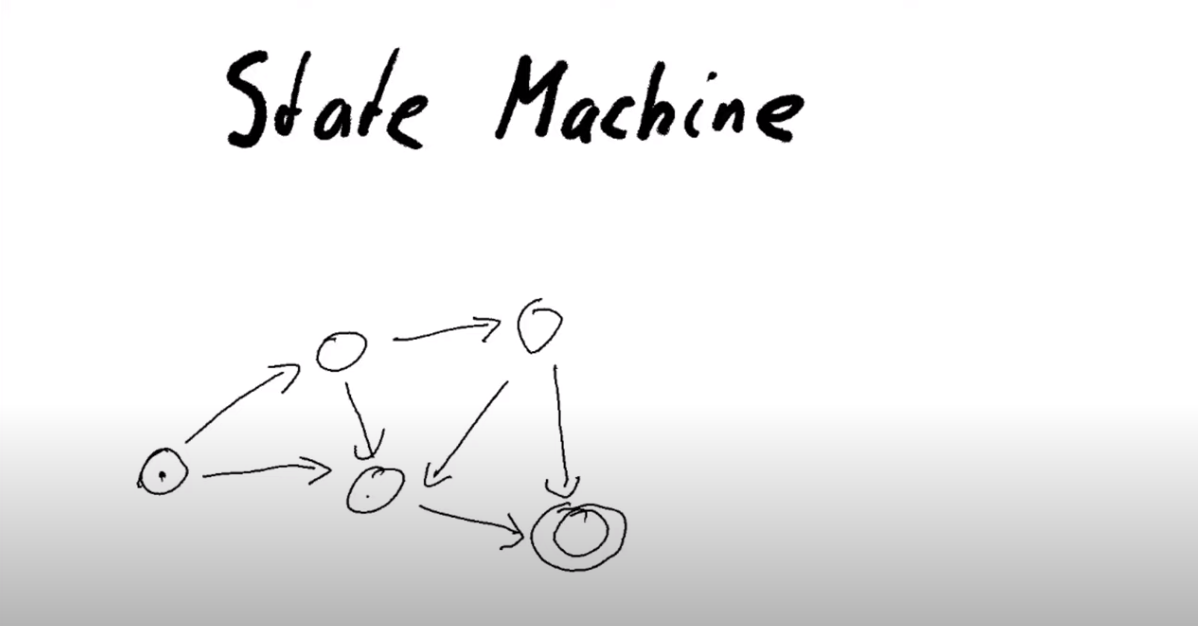
If we look again at how our games works, then we can consider it to be a state machine.

The initial state would be [Hash], where the first player has made the move.
From the initial state, there are two possible transitions. One where Bob plays, and the other where Bob does not player and Alice can reclaim.
In the diagram, all the nodes correspond to states, and all the arrows correspond to transitions.
In the blockchain, the state machine will be represented by a UTxO sitting at the state machine address. The state of the machine will be the datum of that UTxO. A transition will be a transaction that consumes the current state, using a redeemer that characterizes the transition, and then produces a new UTxO at the same address, where the datum now reflects the new state.
This pattern fits a lot of situations very nicely, and there is special support in the Plutus libraries to implement such state machines. We will see that when we use this approach, our code will be much shorter.
The support for state machines is in the package plutus-contract, in module Language.Plutus.Contract.StateMachine
A StateMachine has two type parameters, s and i, which stand for state and input. These correspond to datum and redeemer, respectively.
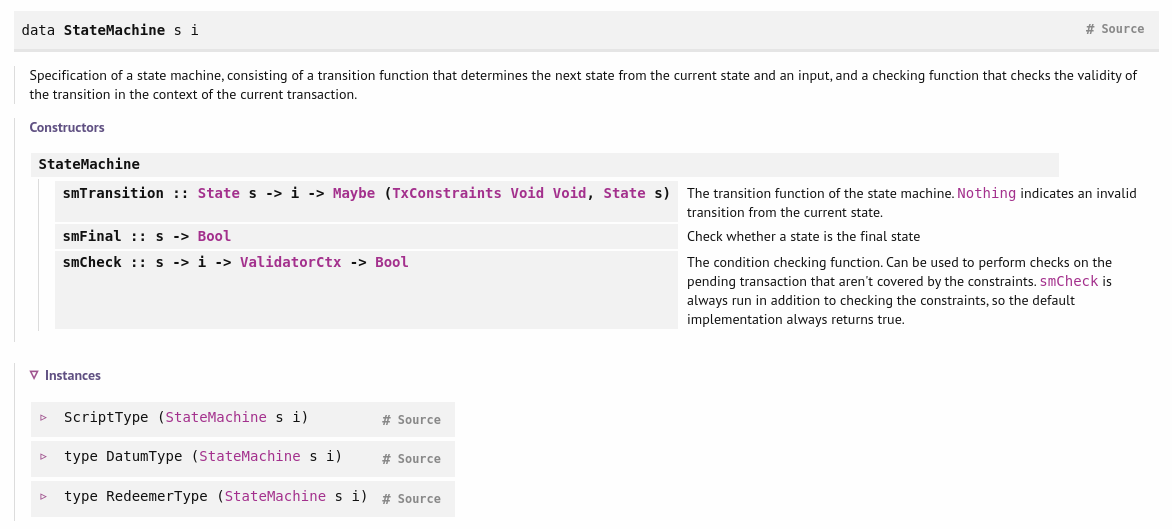
It is a record type with four fields. Probably the most important one is smTransition, which defines which transitions can move which states which other states.
The State s type is basically the datum. It consists of the state itself and a value. Remember that the state of the state machine is represented by a UTxO, which has a datum and a value.
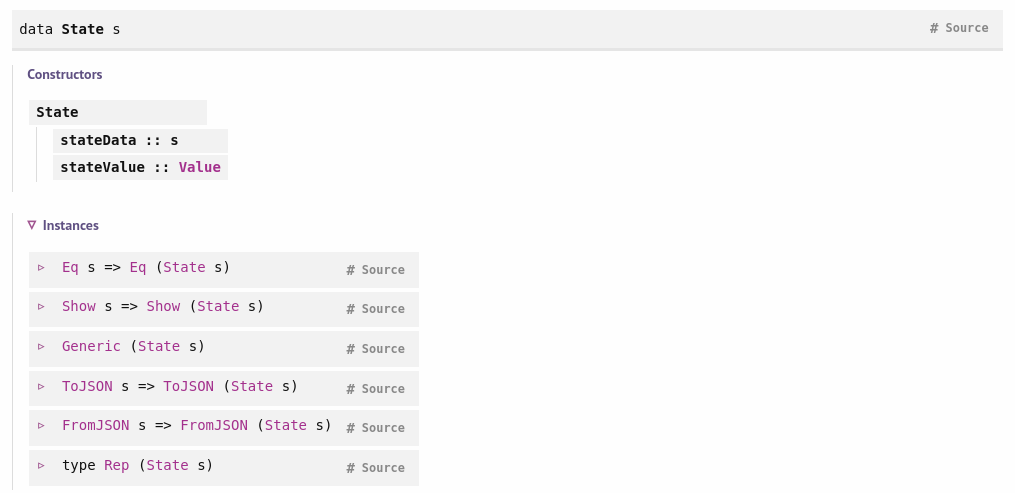
Given the state type s, and a transaction that tries to consume this UTxO with a redeemer i, we can indicate that this transition is not allowed by returning Nothing. If it is allowed, we return a tuple.
The second component of the tuple is the new state (the new datum and value), which is the new UTxO sitting at the same address, with the first UTxO having been consumed.
The first component of the tuple specifies additional constraints that the transaction that does this must satisfy. Until now, we have only seen constraints in off-chain code.
We then have a function setFinal which is predicated on the state which tells us whether it is a final state or not. Final states are special in that the resulting State from the setTransition function must have no value attached to it, and the output does not get produced. The machine ends there.
The function smCheck is very similar to the setTransition function. It gets the datum, the redeemer and the context and returns a bool. It provides additional checks that can\'t be expressed by the TxConstraints in setTransition.
Finally, smThreadToken allows us to identify the UTxO which represents the current state. This is in the even that there us more than one UTxO sitting at the address of the state machine. It uses the same trick that we have seen before of using an NFT sitting in the value of the correct UTxO. You could, however, always return Nothing from smThreadToken and use some other mechanism to identify the correct UTxO.
The same game from example 1 has been implemented using a state machine, in the following module.
The first parts of the code are the same - we have the same Game type and the same GameChoice. The first change we notice is with GameDatum.
We have added a second constructor to GameDatum called Finished. This will represent the final state of the state machine. It won\'t correspond to a UTxO, but we need it for the state machine mechanism to work.
And this adds a little more complexity to the definition of equality.
instance Eq GameDatum where
{-# INLINABLE (==) #-}
GameDatum bs mc == GameDatum bs' mc' = (bs == bs') && (mc == mc')
Finished == Finished = True
_ == _ = False
The redeemer is exactly the same as before. The lovelaces and gameDatum helper functions are also exactly the same as before.
Now we get to the transition function, which sort of corresponds to the mkGameValidator function that we used in the previous example. It is basically the core business logic.
transition :: Game -> State GameDatum -> GameRedeemer -> Maybe (TxConstraints Void Void, State GameDatum)
The transition function takes the Game, then a State GameDatum, which, as we saw in the definition of StateMachine, is a pair consisting of the datum and the value. Thirdly, it takes the redeemer, and then returns a Maybe of the new state and constraints on the transaction.
Let\'s compare the transition function of the state machine with the mkGameValidator function from our first game version.
transition :: Game -> State GameDatum -> GameRedeemer -> Maybe (TxConstraints Void Void, State GameDatum)
transition game s r = case (stateValue s, stateData s, r) of
(v, GameDatum bs Nothing, Play c)
| lovelaces v == gStake game -> Just ( Constraints.mustBeSignedBy (gSecond game) <>
Constraints.mustValidateIn (to $ gPlayDeadline game)
, State (GameDatum bs $ Just c) (lovelaceValueOf $ 2 * gStake game)
)
(v, GameDatum _ (Just _), Reveal _)
| lovelaces v == (2 * gStake game) -> Just ( Constraints.mustBeSignedBy (gFirst game) <>
Constraints.mustValidateIn (to $ gRevealDeadline game) <>
Constraints.mustPayToPubKey (gFirst game) token
, State Finished mempty
)
(v, GameDatum _ Nothing, ClaimFirst)
| lovelaces v == gStake game -> Just ( Constraints.mustBeSignedBy (gFirst game) <>
Constraints.mustValidateIn (from $ 1 + gPlayDeadline game) <>
Constraints.mustPayToPubKey (gFirst game) token
, State Finished mempty
)
(v, GameDatum _ (Just _), ClaimSecond)
| lovelaces v == (2 * gStake game) -> Just ( Constraints.mustBeSignedBy (gSecond game) <>
Constraints.mustValidateIn (from $ 1 + gRevealDeadline game) <>
Constraints.mustPayToPubKey (gFirst game) token
, State Finished mempty
)
_ -> Nothing
where
token :: Value
token = assetClassValue (gToken game) 1
The first thing to notice is that, in the transition function we do not need to do our initial check for the presence of the NFT. This is because the state machine takes care of that, so long as we set the last field of the StateMachine to some NFT asset class.
-- we no longer need something like this for our state machine version
traceIfFalse "token missing from input" (assetClassValueOf (txOutValue ownInput) (gToken game) == 1) &&
Let\'s remind ourselves how we defined the first case where the first player had moved, the second player had not yet moved, and now the second player wants to make a move. We had six conditions.
(GameDatum bs Nothing, Play c) ->
traceIfFalse "not signed by second player" (txSignedBy info (gSecond game)) &&
traceIfFalse "first player's stake missing" (lovelaces (txOutValue ownInput) == gStake game) &&
traceIfFalse "second player's stake missing" (lovelaces (txOutValue ownOutput) == (2 * gStake game)) &&
traceIfFalse "wrong output datum" (outputDatum == GameDatum bs (Just c)) &&
traceIfFalse "missed deadline" (to (gPlayDeadline game) `contains` txInfoValidRange info) &&
traceIfFalse "token missing from output" (assetClassValueOf (txOutValue ownOutput) (gToken game) == 1)
Let\'s see how these conditions are reflected in the state machine version.
transition game s r = case (stateValue s, stateData s, r) of
(v, GameDatum bs Nothing, Play c)
| lovelaces v == gStake game -> Just ( Constraints.mustBeSignedBy (gSecond game) <>
Constraints.mustValidateIn (to $ gPlayDeadline game)
, State (GameDatum bs $ Just c) (lovelaceValueOf $ 2 * gStake game)
)
We can access the value and datum components of our State parameter using stateValue and stateData, which gives us the triple for our case statement of value, datum and redeemer.
Our matching case is now
First we check that the number of lovelaces in the value matches the stake of the game, which was our second condition in our code for this case from example 1. If this condition is satisfied, we return a Just pair. The first component of the pair is the constraints on the transaction (formulated from the Constraints module that we know from off-chain code). The two constraints that comprise this part of the pair correspond to the first and fifth conditions in our old code.
The second component of the pair is the new state - the resulting UTxO - which again is given by datum and value. So here we are specifying that the datum of the new UTxO will contain both players\' choices, and the value of the UTxO will contain both players\' stakes. We leave the NFT out of this condition, even though it will be present in the UTxO, and that is again because the state machine implicitly takes care of this for us.
This second component corresponds with the third and fourth conditions from our old code.
The sixth condition from our old code related to the NFT which, as we have seen, we do not need to worry about.
Now let\'s compare the code from the second interesting case, where the second player has played and the first player sees that they have won.
-- old version
(GameDatum bs (Just c), Reveal nonce) ->
traceIfFalse "not signed by first player" (txSignedBy info (gFirst game)) &&
traceIfFalse "commit mismatch" (checkNonce bs nonce c) &&
traceIfFalse "missed deadline" (to (gRevealDeadline game) `contains` txInfoValidRange info) &&
traceIfFalse "wrong stake" (lovelaces (txOutValue ownInput) == (2 * gStake game)) &&
traceIfFalse "NFT must go to first player" nftToFirst
-- new version
(v, GameDatum _ (Just _), Reveal _)
| lovelaces v == (2 * gStake game) -> Just ( Constraints.mustBeSignedBy (gFirst game) <>
Constraints.mustValidateIn (to $ gRevealDeadline game) <>
Constraints.mustPayToPubKey (gFirst game) token
, State Finished mempty
)
Again, we see that the first thing we do is to check that the correct stake exists, and if it does, we again return a Just. So, this takes care of condition four from the old code. Condition one from the old code is taken care of by the Constraints.mustBeSignedBy constraint in the new code.
Note that we do not check the nonce in the new code. The reason for this is that this check cannot be expressed in terms of a constraint. And this is exactly what the smCheck function is for, and we will see how this is used for this in a moment.
We can also match up the deadline check from each code sample, with it being defined using Constraints.mustValidateIn in the new code.
In the old code, when the game was over, we returned the NFT to the first player. In the new code, we also make sure the NFT goes back to the first player, but we also specify the Finished state and say that there is no money left in the contract using mempty.
Now we compare the old and the new code for the third case where the first player reclaims their stake when the second player does not play by the deadline.
-- old version
(GameDatum _ Nothing, ClaimFirst) ->
traceIfFalse "not signed by first player" (txSignedBy info (gFirst game)) &&
traceIfFalse "too early" (from (1 + gPlayDeadline game) `contains` txInfoValidRange info) &&
traceIfFalse "first player's stake missing" (lovelaces (txOutValue ownInput) == gStake game) &&
traceIfFalse "NFT must go to first player" nftToFirst
-- new version
(v, GameDatum _ Nothing, ClaimFirst)
| lovelaces v == gStake game -> Just ( Constraints.mustBeSignedBy (gFirst game) <>
Constraints.mustValidateIn (from $ 1 + gPlayDeadline game) <>
Constraints.mustPayToPubKey (gFirst game) token
, State Finished mempty
)
These two match up fairly easily, with the lovelaces being the condition on the left in the new code, and the remaining conditions on the right in the new code matching up with corresponding conditions in the old code. Again we add the Finished state in the new code.
The last case, where the second player has played and the first player does not reveal by the deadline, probably because they lost.
(GameDatum _ (Just _), ClaimSecond) ->
traceIfFalse "not signed by second player" (txSignedBy info (gSecond game)) &&
traceIfFalse "too early" (from (1 + gRevealDeadline game) `contains` txInfoValidRange info) &&
traceIfFalse "wrong stake" (lovelaces (txOutValue ownInput) == (2 * gStake game)) &&
traceIfFalse "NFT must go to first player" nftToFirst
(v, GameDatum _ (Just _), ClaimSecond)
| lovelaces v == (2 * gStake game) -> Just ( Constraints.mustBeSignedBy (gSecond game) <>
Constraints.mustValidateIn (from $ 1 + gRevealDeadline game) <>
Constraints.mustPayToPubKey (gFirst game) token
, State Finished mempty
)
The conditions in the old and the new code for this last case can be matched up in a very similar way to those for the third case.
All other states with arbitrary transitions are invalid, and we indicate that by returning Nothing.
In the end we see that while the conditions themselves may not be much shorter in the new version than those in the old version, we also see that we only need one helper function.
But we are not yet finished defining the state machine. There are some other fields in the StateMachine record.
One is smFinal, which lets us define what the final states are. For us, it is just the Finished state. We define a helper function that we can use for this field.
Another field to define is smCheck. Recall that this is where we can put conditions that cannot be expressed as Constraints. So this is where we can put our nonce check.
We define another helper function check, with two auxiliary ByteString parameters to represent the zero and one choices, for reasons that we have seen before. We also pass it the datum, redeemer and context, and it will return us a boolean.
We don\'t need the script context, but we need the datum to get the second player\'s choice (which the first player is claiming is the same as theirs), and the redeemer to get the nonce that the first player is claiming to have used. We can then check that the hash of the choice and the nonce match the original hash from the datum.
check :: ByteString -> ByteString -> GameDatum -> GameRedeemer -> ScriptContext -> Bool
check bsZero' bsOne' (GameDatum bs (Just c)) (Reveal nonce) _ =
sha2_256 (nonce `concatenate` if c == Zero then bsZero' else bsOne') == bs
In all other situations, those that are not checking the revealed nonce, we don\'t need to perform any checks.
Now we can define our state machine.
gameStateMachine :: Game -> ByteString -> ByteString -> StateMachine GameDatum GameRedeemer
gameStateMachine game bsZero' bsOne' = StateMachine
{ smTransition = transition game
, smFinal = final
, smCheck = check bsZero' bsOne'
, smThreadToken = Just $ gToken game
}
Our old mkGameValidator can now be replaced by using machinery provided by the state machine. There is a mkValidator function which will take our state machine, generated by the gameStateMachine function and turn it into a validator with exactly the same type as we had in the old code.
mkGameValidator :: Game -> ByteString -> ByteString -> GameDatum -> GameRedeemer -> ScriptContext -> Bool
mkGameValidator game bsZero' bsOne' = mkValidator $ gameStateMachine game bsZero' bsOne'
In the old code we had this mechanism to bundle datum and redeemer into a Gaming type.
-- old code
data Gaming
instance Scripts.ScriptType Gaming where
type instance DatumType Gaming = GameDatum
type instance RedeemerType Gaming = GameRedeemer
But now we can define this as.
We also provide an alternate version of gameStateMachine, which doesn\'t take the two auxiliary ByteStrings. This won\'t work for on-chain code, but for off-chain code it works just fine.
gameStateMachine' :: Game -> StateMachine GameDatum GameRedeemer
gameStateMachine' game = gameStateMachine game bsZero bsOne
We have the same boilerplate as before for gameInst, gameValidator and gameAddress, which we won\'t copy again here.
The function gameClient is new. It is a StateMachineClient, and this is what we need to interact with our state machine from our wallet in the Contract monad.

As you can see from the definition, it contains a StateMachineInstance. And the StateMachineInstance in turn is just a StateMachine and the corresponding script instance.

Once we have that, the StateMachineClient still needs to be bundled with a so called chooser, which is the mechanism, from the off-chain code, for finding the UTxO that represents our state machine. In general there will be a list of UTxOs at the address of the state machine, and scChooser is a function that specifies which to pick.
We don\'t have to worry about that, because we are using the NFT approach, which means that the choosing is taken care of for us automatically.
There is a function mkStateMachineClient that takes a StateMachineInstance and returns a StateMachineClient, and this uses the default implementation of the chooser. And this will do the right thing and pick the UTxO that contains our NFT.
gameClient :: Game -> StateMachineClient GameDatum GameRedeemer
gameClient game = mkStateMachineClient $ StateMachineInstance (gameStateMachine' game) (gameInst game)
Now, gameClient can be used to interact with the state machine from off-chain code.
FirstParams is exactly the same, so we won\'t repeat it here.
There is one small nuisance. The state machine contracts provided by the state machine module have a specific constraint on the error type. One error type that works is SMContractError.
But we want to do what we did in the last lectures and always use Text as the error type. To achieve this we will use a helper function to convert the SMContractError type into a Text type. Recall that show will return a String and pack will convert a String into a Text.
mapError' :: Contract w s SMContractError a -> Contract w s Text a
mapError' = mapError $ pack . show
So now the first player contract becomes much shorter and more compact.
The beginning is the same.
firstGame :: forall w s. HasBlockchainActions s => FirstParams -> Contract w s Text ()
firstGame fp = do
pkh <- pubKeyHash <$> Contract.ownPubKey
let game = Game
{ gFirst = pkh
, gSecond = fpSecond fp
, gStake = fpStake fp
, gPlayDeadline = fpPlayDeadline fp
, gRevealDeadline = fpRevealDeadline fp
, gToken = AssetClass (fpCurrency fp, fpTokenName fp)
}
Now, we take the client along with some values that we get as before.
client = gameClient game
v = lovelaceValueOf (fpStake fp)
c = fpChoice fp
bs = sha2_256 $ fpNonce fp `concatenate` if c == Zero then bsZero else bsOne
There is a function runIntialise that starts a state machine and creates a UTxO at the state machine address. It takes the client as its first argument and then it needs the initial datum and the initial value for the UTxO sitting at that address. And it will automatically put the NFT there as well.
void $ mapError' $ runInitialise client (GameDatum bs Nothing) v
logInfo @String $ "made first move: " ++ show (fpChoice fp)
Now, the state machine is setup and the first player has made their move.
We wait until the play deadline.
In our first example, we defined a helper function findGameOutput to get the current UTxO, but this can now be done in a simpler way using getOnChainState.

The function getOnChainState will return a Just OnChainState if it finds the state machine, or a Nothing if it does not find it.

So what is OnChainState? It is a tuple consisting of TypedScriptTxOut and TypedScriptTxOutRef. This is similar to what utxoAt gives us, which was a map of TxOutRefss to TxOutss. This is similar in that it is a output and its reference, but it is this Typed version that we haven\'t seen before.
All that does is bundle what we know from before, TxOut, but additionally it provides the datum. You\'ll recall that in our off-chain code we always have to scramble and write helper functions to access the datum once we had found the UTxO. We had to look up the datum hash, which could fail, and so on. TypedScriptTxOut hides all this from us.
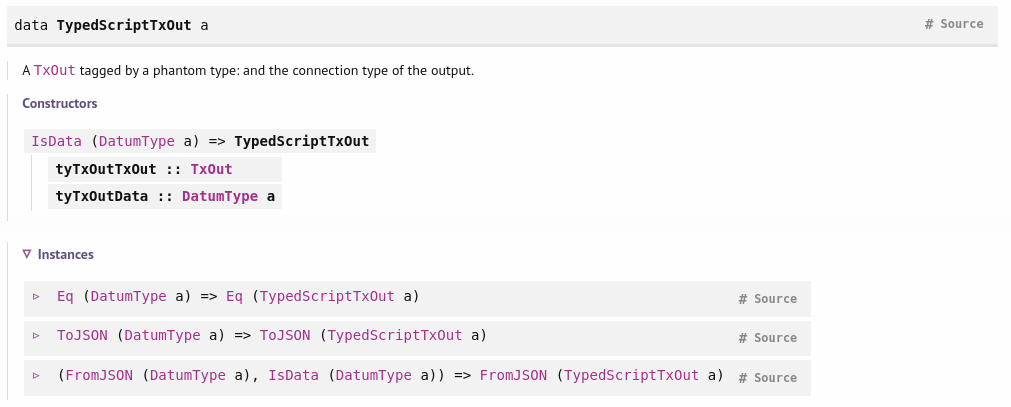
As before, we should never get Nothing for m.
case m of
: Nothing -> throwError \"game output not found\"
Now, we are only interested in the TypedScriptTxOut parameter, which we assign to o, and use it to lookup the datum using tyTxOutData.
As before we have the two cases. Either the second player has moved, or they haven\'t moved.
If they haven\'t moved, we must reclaim. Earlier we had lots of code to setup the lookups and constraints that we needed. How we only need one line, and the important function here is runStep, which creates and submits a transaction that will transition the state machine.
It takes as input the client and the redeemer. It then returns a TransitionResult, which we are not using in this example, but basically encodes whether it succeeded or failed.

Which means, that we can use runStep with just the client and redeemer to replace all the lookups, the constraints, the transaction submissions and the waiting.
The way it works it that the transition function is that all the necessary constraints have been defined as part of the state machine.
GameDatum _ Nothing -> do
logInfo @String "second player did not play"
void $ mapError' $ runStep client ClaimFirst
logInfo @String "first player reclaimed stake"
The second case is that the first player did reveal, and we again use the runStep function to transition the state machine.
GameDatum _ (Just c') | c' == c -> do
logInfo @String "second player played and lost"
void $ mapError' $ runStep client $ Reveal $ fpNonce fp
logInfo @String "first player revealed and won"
And in all other situations, the second player wins.
The second player\'s contract is very similar, and just as simple.
secondGame :: forall w s. HasBlockchainActions s => SecondParams -> Contract w s Text ()
secondGame sp = do
pkh <- pubKeyHash <$> Contract.ownPubKey
let game = Game
{ gFirst = spFirst sp
, gSecond = pkh
, gStake = spStake sp
, gPlayDeadline = spPlayDeadline sp
, gRevealDeadline = spRevealDeadline sp
, gToken = AssetClass (spCurrency sp, spTokenName sp)
}
client = gameClient game
m <- mapError' $ getOnChainState client
case m of
Nothing -> logInfo @String "no running game found"
Just ((o, _), _) -> case tyTxOutData o of
The only case we need to address is where we haven\'t played yet, and so should play. And, in order to play, we again use the runStep function.
GameDatum _ Nothing -> do
logInfo @String "running game found"
void $ mapError' $ runStep client $ Play $ spChoice sp
logInfo @String $ "made second move: " ++ show (spChoice sp)
We then wait until the reveal deadline has passed, then get the new state.
If there is no state, the first player has won and claimed their winnings.
Otherwise, we have won, and we claim our winnings using the runStep function, giving the ClaimSecond redeemer.
Just _ -> do
logInfo @String "first player didn't reveal"
void $ mapError' $ runStep client ClaimSecond
logInfo @String "second player won"
And a final catch all.
That concludes the state machine version of the code.
What is particularly nice about this approach is that we don\'t need to replicate logic anymore. We have discussed how off-chain code is used for construction and on-chain code is used for checking. When we use the state machine approach, we define logic that can be used for both, so we do not need to write it explicitly for the off-chain part and the on-chain part of the code.
In order to test this, there is a module called Week07.TestStateMachine in the example code. It is exactly the same as the test for the old code, with one exception, and that is just that instead of importing Week07.EvenOdd, it imports Week07.StateMachine. This is a quick and dirty way of doing things - we could, of course, have written a script that was parameterized over the contract we want to use.
If you load Week07.TestStateMachine in the REPL and run test, you should get exactly the same results as before.
Conclusion
State machines are not always appropriate, but when they are, you should definitely use them. They dramatically reduce the amount of code you have to write, and also reduce sources of errors.
The state machine mechanism automatically ensures that you have on-chain and off-chain code that are working correctly together. Until now, we have always had to take care of that ourselves.